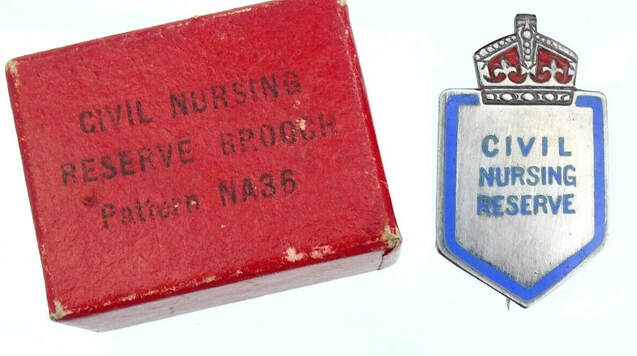WW2 ARP Civil Nursing Reserve & Auxiliary Uniforms and Insignia / Badges
|
A dedicated ARP branch for nurses was created within the Civil Defence Service. Created in April 1938, the Civil Nursing Reserve recruited nurses to serve in hospitals and first aid posts. Ranks of the CNR were made up of trained nurses, assistant nurses already earning a living as a nurse and volunteer auxiliary nurses who had undergone a basic two-week training (and who had joined as part of a call up to National Service).
The uniform was a blue with fine white stripe, A-line dress with a square collar. A fabric badge of red ARP letters embroidered on the same material as the uniform was sewn centrally to the chest and nursing auxiliaries had a red NA badge sewn centrally on their overalls (see poster right). A white cotton apron could be worn over the top of the uniform. |
WW2 Civil Defence Nursing Auxiliary
|
Nursing Auxiliaries (NAs) were women aged 18 to 55 without prior nursing experience. They volunteered through the Civil nursing Reserve and received two weeks' training at a hospital covering first aid, home nursing and practical hospital work paid for by the government. General the role was a full-time position doing 48 hours per week.
Once they passed training an NA could be employed in any number of locations - first aid posts, casualty evacuation trains, medical aid posts in shelters or rest centres. |
WW2 Nursing Auxiliary Uniform & Apron - ARP Pattern 46
The Nursing Auxiliary uniform (ARP Pattern 46) was in a blue cotton with a very fine white stripe. It featured a winged collar, a V-shaped yoke and the letters 'NA' embroidered in red on a small oblong of material that was then sewn to the front. A single patch pocket was placed on the right-hand-side of the skirt.
Sleeves were slightly puffed with fold back cuffs above the elbow. The uniform fastened with two removable buttons (taken off when the garment was washed) at the back of the neck and one at bottom rear of the skirt. A belt with two removable buttons fastened at the front. A simple white apron was worn over the uniform fixed with safety pins to the front and two buttons at the rear.
Sleeves were slightly puffed with fold back cuffs above the elbow. The uniform fastened with two removable buttons (taken off when the garment was washed) at the back of the neck and one at bottom rear of the skirt. A belt with two removable buttons fastened at the front. A simple white apron was worn over the uniform fixed with safety pins to the front and two buttons at the rear.
Civil Nursing Reserve Greatcoat
Many nursing reserve members were issued with the grey/blue gaberdine greatcoat with fleece lining. This item of clothing is often seen in period photos worn with the felt cap. Some photos show the CD breast badge (either the embroidered or gabardine) sewn onto the left breast or a Civil Nursing Reserve shield breast badge.
Civil Nursing Reserve Embroidered Greatcoat / Overcoat Badge
An embroidered badge was manufactured to be worn on the Civil Nursing Reserve greatcoat (overcoat). It was sewn to the left breast of the greatcoat. The design of the badge mirrored that of the enamel Civil Nursing Reserve badge (see below) but with a red scarlet background.
Civil Nursing Reserve Pattern NA36 Brooch Pin Badge
|
From June 1940, nurses of the Civil Nursing Badge could wear this brooch pin badge on the left side of their uniform and later also as a cap badge. Badges were marked 'H.W.M.' (H W Miller Ltd) and 'J. R. Gaunt Ltd. London'.
Some of these were available in sterling silver (some marked 'W.J.D B'HAM' (William James Dingley), 'L.S. & Co.' (Lionel Smith & Company, Birmingham) and 'A.BROS, B'HAM' (Adie Brothers)), probably as a private purchase. |
Civil Nursing Reserve Red Star
|
Should a Nursing Auxiliary (N.A.) of the Civil Nursing Reserve complete 12 months' continuous "satisfactory service" then they were issued with a six-pointed red star by the Ministry of Health.
The star was to be worn as follows: "The star should be sewn on your overalls over the Nursing Auxiliary badge or, if you are a member of the British Red Cross Society or the St. John Ambulance Brigade, as directed by the Society or the Brigade." If a second star was awarded: "The second star should be sewn on your overalls an inch away from the first star, which should be adjusted where necessary to bring the two stars into line in the middle of the overalls above the N.A. badge. If, however, you are a member of the British Red Cross Society or the St. John Ambulance Brigade, as directed by the Society or the Brigade." |
Embroidered CD Badge (ARP Pattern 80) for ARP Pattern 46 Nurses Uniform
With the change of ARP to CD in 1941, the ARP badge was dropped in favour of a yellow CD on blue/white fabric.











